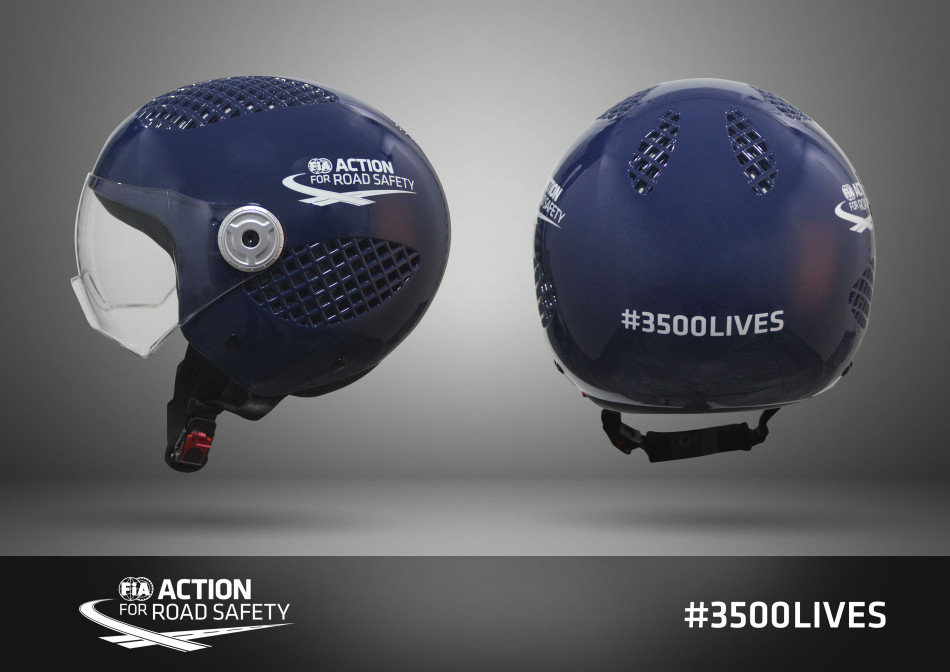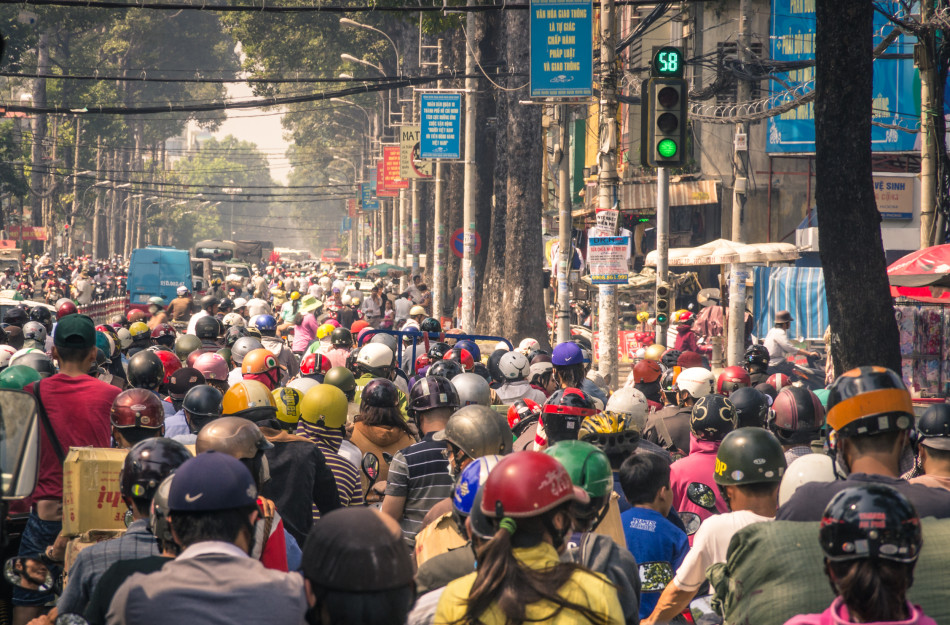FIA Leads Global Project for affordable, High-Safety Helmets
The FIA is leading the effort to develop an affordable, high-standard motorcycle helmet aimed at saving lives worldwide

There are more than three hundred million motorbikes, mopeds and scooters around the world, and 80 per cent of these are in Asia. But the majority of countries in this region allow for the use of helmets that provide lower protection compared to the United Nations helmet standards, which are mandated across most of Europe and in 79 countries around the world.
Viewed globally, this is an important issue as there are currently over 30 national helmet standards and they vary significantly in terms of safety. The majority of helmets from the Asian market, for instance, would be unable to meet the UN helmet regulation (UN Reg. 22.05). But helmets available in markets that meet the UN regulation are too expensive and are not specifically designed for the hot and humid climate typical for Asia.
This has created a dangerous disparity – the region of the world with the most motorbike riders accepts the use of helmets with lower safety performance. And as the usage of powered two-wheel vehicles increases, so does the fatality rate, to epidemic proportions. Looking at this problem globally, one of the key objectives of the UN Decade of Action for Road Safety is to reduce motorcycle casualties by encouraging the use of safe helmets. The UN study found that up to 3.4 million deaths might result from motorcycle crashes between 2008 and 2020. As many as 1.4 million of those fatalities could be avoided with the proper use of safe helmets. A policy on wearing motorcycle helmets is, therefore, essential for promoting safety.
This is why the FIA has been working on a solution and it is an idea that has come from the very top.
“We were given the challenge by President Jean Todt to make a helmet available at a wholesale price of 10 US dollars that is both UN Reg. 22.05-certified and comfortable to wear in hot and humid countries,” says FIA Head of Competitor Safety Nuno Costa, who is applying his experience of developing competition helmets to this mobility project. “So that is how the project started and with the help of our network of helmet manufacturers we identified some areas to develop an affordable helmet that would meet these two requirements – affordability and wearability.”
Before embarking on such an ambitious goal, the FIA had to reflect on an important question. Why should it devote resources to this area?
The FIA has two pillars, Sport and Mobility. The Mobility mission is to ensure safe, affordable and clean systems of transport are available to all. President Todt was clear about the need to lead this effort and asked FIA Safety Director Adam Baker to personally oversee the project.
“The President asked us to identify key areas where the work of the Sport division could be exploited for the benefit of road users. The most important projects we have targeting this objective are in the area of road safety,” says Baker. “According to the UN, riders of motorcycles are 26 times more likely to die in traffic accidents than passenger car occupants, making that mode of transport a significant contributor to the 1.35 million total fatalities each year on our roads. From this UN data, we can see that the biggest potential for a reduction in fatalities for a given investment of resource is in motorcycle riders, and specifically the adoption of safe helmets. So this idea of President Todt, in terms of all the other things we do for road safety, is arguably the most important and effective way to achieve a significant reduction in the 1.35 million figure.”
Now all the FIA safety engineers had to do was develop a product that does not exist on the market and do so in record time. Clearly, not an easy task or it would have been done before.
“If you consider the various product characteristics – cost, ventilation, weight and safety performance – it’s a combination that hasn’t existed before,” says Baker. “The market forces didn’t naturally produce a product of this type because in the majority of countries where you have the UN Reg. 22.05, the price range of helmets on the market is well above the $10 US wholesale price point, and in lower-income countries you don’t have the requirement for UN Reg. 22.05.”
To achieve this, Baker and his team started with a number of European helmets that were already lightweight with good ventilation and fine-tuned the design to make it affordable without diminishing its safety performance.
Working together with Spanish helmet manufacturer NZI, FIA safety engineers refined the design and came up with a helmet that could be produced at an affordable price and pass the UN safety tests. This was achieved at the end of last year and the next step is to produce 3,000 of these helmets to distribute for field testing.
“We know the helmet is safe but we want to make sure it’s also fit for purpose in hot and humid climates,” says Baker. “We are going to get riders’ feedback to prove this is a suitable product.”
Safety Transfer
This is where the FIA’s twin pillars of Sport and Mobility are proving truly potent. The FIA Sport department, which is normally tasked with developing safety equipment for competitors, has used its expertise to develop a highly-efficient helmet and the Mobility side of the FIA is bringing that design to the market.
The FIA’s Mobility department has identified three countries in which to test the first batch of helmets – India, Jamaica and Tanzania. It will work with FIA member clubs, road safety agencies and local stakeholders in each of those countries to promote higher-quality helmets to a cross-section of motorcycle riders.
“The aim is to start introducing these helmets to countries that are at different kinds of development in relation to standards,” says FIA Head of Road Safety and Global Advocacy Luca Pascotto. “Governments are under the impression that existing UN standards lead to expensive, heavy and unwearable helmets for tropical countries. This creates the conditions for significantly low-standard helmets available in the market. And we know that the use of non-standard, cheap and low-quality motorcycle helmets has the potential to undermine efforts aimed at reducing the burden of road traffic injuries associated with motorcycle crashes.”
NZI is producing these helmets at its China factory and is aiming to ship them by the end of April, depending on whether restrictions are still in place from the Coronavirus pandemic.
Ultimately, the FIA does not want to be a helmet manufacturer or sales distributor. Rather it wants to create a situation where market forces create the need for this product.
As Pascotto says: “We need to increase community awareness of the effectiveness of the helmet in reducing the risk of motorcycle injury and disability and, at the same time, engage with helmet producers to show that there could be a market for better quality helmets. This would generate a response from the local industries to adapt the current production and from the government to upgrade legislations.”
Part of the overall strategy is to show national governments that they should raise the level of standards because of the tremendous impact this measure would have on road safety. This is where President Todt’s role as the UN Special Envoy for Road Safety is beneficial, as he can lobby national governments to raise standards while demonstrating that there are no longer any roadblocks to doing this. He can also influence road safety programmes run by private companies.
“Many companies are looking at our helmet demonstration programme with interest as they want to ensure their initiatives can deliver larger road safety gains. We are involving the private sector to help our clubs strengthen their action; facilitating helmet scrappage schemes as part of training sessions, like in Jamaica; reaching out to fleet operators, such as the BodaBoda motorcycle taxi drivers in Tanzania; and creating a motorcycle young ambassador programme in Mumbai.”
Market Forces
The next step will be to sign up more manufacturers to produce their own version of the low-cost, high-safety helmet. The FIA recently made a major breakthrough in this regard by agreeing a deal with Steelbird, a helmet manufacturer based in India.
Steelbird already produces an approved helmet for the Indian market so there are a lot of riders that are used to buying that brand. They are therefore more likely to buy an even safer version of the helmet for the same price when
it comes to the market.
The FIA is also discussing a similar programme with a Vietnamese helmet manufacturer. The AIP Foundation, a road safety organisation based in Vietnam, is opening a new 20,000 sqm facility in Hanoi to expand the production of low-cost tropical helmets, including UN ECE 22.05- standard helmets. These are just two of many markets that would benefit from such a development. The FIA is determined to disrupt these sub-standard markets worldwide.
As Baker puts it: “One reason these companies are interested to partner with us is they see the work of the FIA as a potentially disruptive force in the market and they want to be the first to benefit from what we are aiming to achieve in what is already quite a crowded commercial space. They recognise the enormous scope of the network of FIA mobility clubs and that the FIA President has successfully advocated at government level for additional countries to mandate the UN Reg. 22.05 in the coming years, and they’re going to be ready with the first product when these markets open up to the UN regulation. The manufacturers who can adapt quickly will reap the rewards.”
For the FIA, a reduction in road fatalities will be reward enough.
Should any other manufacturers wish to collaborate with the FIA on this important programme, they can contact the FIA Safety Department at: safety@fia.com


 Facebook
Facebook Twitter
Twitter






